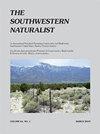DOES CLEISTOGAMOUS SELF-FERTILIZATION PROVIDE REPRODUCTIVE ASSURANCE AGAINST SEED PREDATION IN RUELLIA HUMILIS?
IF 0.3
4区 环境科学与生态学
Q4 Agricultural and Biological Sciences
引用次数: 1
Abstract
Mixed mating is thought to be adaptive in many species of flowering plants because self-fertilization provides reproductive assurance when pollinator densities are low. In species with dimorphic flowers, automatic self-fertilization by small cleistogamous (CL) flowers might also provide reproductive assurance by avoiding floral herbivory. We tested this hypothesis by quantifying flower production, seed production, and seed predation across an entire reproductive season within a Missouri population of Ruellia humilis, a species with mixed mating enforced by dimorphic flowers. The production of CL flowers was delayed relative to the production of open-pollinated chasmogamous (CH) flowers, consistent with the hypothesis of reproductive assurance. The rate of seed predation by larvae of the Noctuid moth Tripudia rectangula was much higher for fruits produced by CH flowers (69%) than by CL flowers (18%). Thus, although CH flowers self-pollinate in the absence of outcross pollen, CL flowers are a much more economical source of selfed seeds, not only because they require fewer resources but also because they experience much lower levels of seed predation. Seed predation by Tripudia is common in many other cleistogamous species of Ruellia native to the southern United States and Mexico and might have played a significant role in the evolution of CL flowers in this large genus.闭锁配花的自交受精是否提供了抵抗种子捕食的生殖保证?
在许多开花植物中,混合交配被认为是适应性的,因为当传粉昆虫密度较低时,自我受精可以提供繁殖保证。在具有二型花的物种中,小型双花(CL)花的自动自我受精也可能通过避免花的草食性来提供繁殖保证。我们通过量化密苏里州胡蜂种群整个繁殖季节的花朵产量、种子产量和种子捕食来检验这一假设,胡蜂是一种由二形态花朵强制混合交配的物种。CL花的生产相对于开放授粉的裂沟花(CH)花的生产延迟,这与生殖保证的假设一致。对于CH花产生的果实,夜蛾幼虫对种子的捕食率(69%)远高于CL花(18%)。因此,尽管CH花在没有异交花粉的情况下自花授粉,但CL花是一种更经济的自花种子来源,这不仅是因为它们需要更少的资源,还因为它们经历的种子捕食水平要低得多。Tripudia对种子的捕食在原产于美国南部和墨西哥的Ruellia的许多其他双雌种中很常见,可能在这个大属CL花的进化中发挥了重要作用。
本文章由计算机程序翻译,如有差异,请以英文原文为准。
求助全文
约1分钟内获得全文
求助全文
来源期刊

Southwestern Naturalist
环境科学-生态学
CiteScore
0.50
自引率
50.00%
发文量
47
审稿时长
18-36 weeks
期刊介绍:
The Southwestern Naturalist (a publication of the Southwestern Association of Naturalists since 1953) is an international journal (published quarterly) that reports original and significant research in any field of natural history. This journal promotes the study of plants and animals (living and fossil) in the multinational region that includes the southwestern United States, Mexico, and Central America. Appropriate submission of manuscripts may come from studies conducted in the countries of focus or in regions outside this area that report significant findings relating to biota occurring in the southwestern United States, Mexico, and Central America. Publication is in English, and manuscripts may be feature articles or notes. Feature articles communicate results of completed scientific investigations, while notes are reserved for short communications (e.g., behavioral observations, range extensions, and other important findings that do not in themselves constitute a comprehensive study). All manuscripts (feature articles and notes) require an abstract in both English and Spanish.
 求助内容:
求助内容: 应助结果提醒方式:
应助结果提醒方式:


